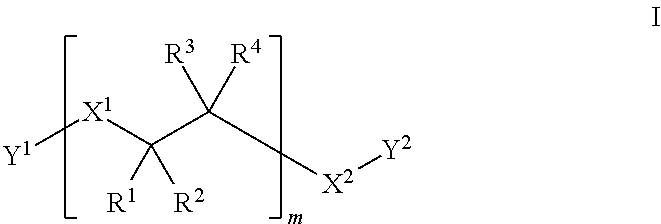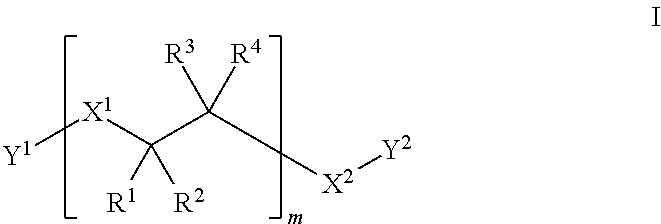Cmp compositions selective for oxide over polysilicon and nitride with high removal rate and low defectivity
a technology of polysilicon and nitride, applied in the direction of other chemical processes, decorative arts, instruments, etc., can solve the problems of overpolishing of the substrate surface, recesses in the sti feature, other topographical defects, etc., and achieve the effect of reducing device quality and performan
- Summary
- Abstract
- Description
- Claims
- Application Information
AI Technical Summary
Problems solved by technology
Method used
Image
Examples
example 1
[0065]Silicon wafers comprising TEOS and polysilicon were polished under identical conditions with Polishing Compositions 1A-1M. The polishing compositions were obtained by combining equal volumes of the abrasive formulations and additive formulations described in Tables 1 and 2 in the combinations set forth in Table 3. The pH of each of Polishing Compositions 1A-1M was adjusted to 4. Each of Polishing Compositions 1A-1M contained 0.4 wt. % wet-process ceria.
[0066]Following polishing, the removal rate for TEOS and polysilicon was determined, and the selectivity for TEOS vs. polysilicon was calculated. The results are set forth in Table
TABLE 3OxidePolishingAdditiveAbrasiveRRPolysiliconCompositionFormulationFormulationType(Å / min)RR (Å / min)Selectivity1AF1WPC1Comparative226470311BF1WPC2Comparative231232721CF2WPC1Invention2296191211DF3WPC2Invention2282171341EF4WPC1Invention2417231051FF5WPC1Invention2282171341GF6WPC1Invention2238191181HF7WPC1Invention2355131811IF8WPC1Invention188140471JF9...
example 2
[0068]This example demonstrates the reduced variability in polysilicon removal rates exhibited by the inventive polishing composition in accordance with an embodiment of the invention.
[0069]Separate substrates comprising high density plasma (“HDP”) oxide-coated silicon, TEOS-coated silicon, silicon nitride-coated silicon, and polysilicon-coated silicon were polished with four different polishing compositions, i.e., Polishing Compositions 2A-2D. Polishing Composition 2A (invention) comprised equal volumes of wet-process ceria formulation WPC1 diluted 1:1.7 with water and additive formulation F3 diluted to 1:1.5 with water to provide 0.23 wt. % of wet-process ceria. Polishing Composition 2B (invention) comprised equal volumes of wet-process ceria formulation WPC1 and additive formulation F3 to provide 0.4 wt. % of wet-process ceria. Polishing Composition 2C (comparative) comprised equal volumes of wet-process ceria formulation WPC1 diluted 1:1.7 with water and additive formulation F1 ...
example 3
[0072]This example demonstrates the effect on dishing and erosion and on polysilicon loss and oxide loss observed with a polishing composition comprising wet-process ceria and a polymer of Formula I in accordance with an embodiment of the invention.
[0073]Separate patterned substrates comprising 100 μm and 900 μm polysilicon features (approximately 2200 Å thick features) initially coated with approximately 1300 Å of oxide on silicon oxide-coated substrates having an oxide trench depth of approximately 3200 Å were polished with three different polishing compositions, Polishing Compositions 3A-3C. Polishing Composition 3A (comparative) comprised a mixture of equal volumes of wet-process ceria formulation WPC1 and additive formulation F9. Polishing Composition 3B (comparative) comprised a mixture of equal volumes of wet-process ceria formulation WPC1 and additive formulation F1. Polishing Composition 3C (invention) comprised a mixture of equal volumes of wet-process ceria formulation WP...
PUM
| Property | Measurement | Unit |
|---|---|---|
| molecular weight | aaaaa | aaaaa |
| particle size | aaaaa | aaaaa |
| particle size | aaaaa | aaaaa |
Abstract
Description
Claims
Application Information
 Login to view more
Login to view more - R&D Engineer
- R&D Manager
- IP Professional
- Industry Leading Data Capabilities
- Powerful AI technology
- Patent DNA Extraction
Browse by: Latest US Patents, China's latest patents, Technical Efficacy Thesaurus, Application Domain, Technology Topic.
© 2024 PatSnap. All rights reserved.Legal|Privacy policy|Modern Slavery Act Transparency Statement|Sitemap



